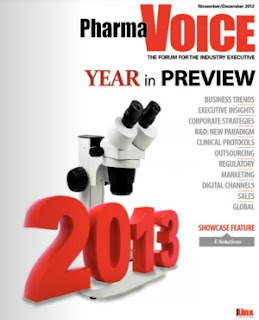 |
| Interesting stats on smartphone usage - more below |
Pew Internet and American Life Project finds half of smartphone owners use their devices to get health information.
The Pew Internet and American Life Project recently published results from the Mobile Health 2012 survey. The findings from this survey offer significant insights into how US consumers use their smartphones to access health information and health apps. These findings are evidence that life science companies have significant opportunities to provide value-added services and products that help patients improve their health.
Key findings from the Mobile Health 2012 survey include…
* 85% of US adults own a cell phone
- 53% are smartphones
* 31% of cell phone users use their phone to search for health information
- In 2010 only 17% of cell phone users used their phones to search for health information
- 52% of smartphone owners access health information via their smartphone
* 19% of smartphone owners have at least one health app on their phone
- Exercise, diet, and weight apps are the most popular
* 9% of cell phone owners receive text updates and alerts about their health or medical issues
- 80% of cell phone owners send and receive text messages
* Those most likely to have signed up for health text alerts...
- Women between the ages of 30 and 64
- Smartphone owners
* Those most likely to use cell phones to search for health information…
- Caregivers
- Those who recently faced a medical crisis
- Those who recently experienced a significant change in their physical health
* 85% of US adults own a cell phone
- 53% are smartphones
* 31% of cell phone users use their phone to search for health information
- In 2010 only 17% of cell phone users used their phones to search for health information
- 52% of smartphone owners access health information via their smartphone
* 19% of smartphone owners have at least one health app on their phone
- Exercise, diet, and weight apps are the most popular
* 9% of cell phone owners receive text updates and alerts about their health or medical issues
- 80% of cell phone owners send and receive text messages
* Those most likely to have signed up for health text alerts...
- Women between the ages of 30 and 64
- Smartphone owners
* Those most likely to use cell phones to search for health information…
- Caregivers
- Those who recently faced a medical crisis
- Those who recently experienced a significant change in their physical health
Key areas to consider when planning mobile health initiatives …
At Tunstall AMAC we are focused on helping build and maintain relationships with patients, caregivers, and healthcare providers to drive awareness and knowledge, support patient adherence, and empower patients to take charge of their health. We offer a wide-variety of personal emergency response and telehealth devices that can be used in the home-setting, and we provide 24/7 monitoring and click-to-chat support services to provide support, information, and educational materials to patients, providers, and payers.
I’d like to hear your thoughts on mobile health information. Is this something you’re doing or considering as a value-added service? Please share your questions and comments, and let’s all learn from each other.









